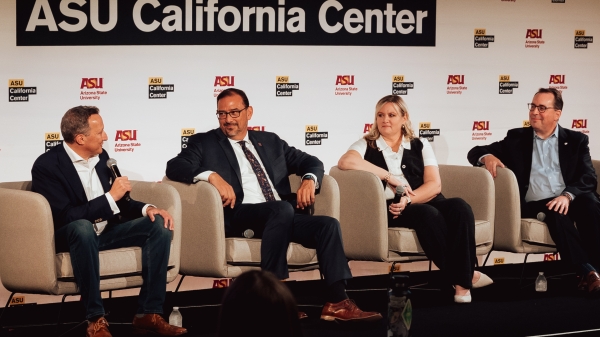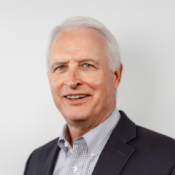ASU Lodestar Center busts myth that nonprofit workers are paid less

Photo courtesy of iStock/Getty Images
If all of the nonprofits in Arizona were grouped together as an industry, they would be the sixth-largest sector in the state — ahead of construction, transportation and warehousing, and accommodation and food service — in economic impact.
That was just one of the revelations in a recent research project by the Lodestar Center for Philanthropy and Nonprofit Innovation at Arizona State University.
The project, called Scope of the Arizona Nonprofit Sector, was based on census and Internal Revenue Service data, and is presented as an interactive tool.
The Lodestar Center, in addition to supporting ASU’s undergraduate and graduate degrees, provides its own professional and continuing education programs, original research and capacity support services for the nonprofit sector, according to Robert Ashcraft, executive director.
“Our center has a big mission and a big portfolio, but one thing is, how do we understand the nonprofit, philanthropic sector, and what are its dimensions? What characteristics does it bring? How and what does that mean relative to other segments of community?” he said.
“And we've revealed a very robust third sector, this quasi-public, nonprofit, philanthropic sector.”
Among the facts about the impact of Arizona nonprofits were:
- The nonprofit industry employs over 222,380 full- and part-time workers, representing nearly 7% of total statewide employment. Nonprofit employees earn 7.3% of the total wages paid in the state.
- The median wage for nonprofit workers is 11.6% greater than the overall state median wage, a difference of nearly $5,000.
- The median full-time wage for workers in the nonprofit sector is $47,305, above the $42,390 median full-time wage for all workers in the state. Higher pay in the health care and higher education subsectors are a main reason for the difference.
- Of the total 28,379 nonprofit organizations in Arizona, the largest category is faith-based, at nearly 5,300, which includes traditional churches, missionary groups and nonprofits such as Habitat for Humanity that deliver social services. The next largest category is education-based, which includes parent-teacher groups and many charter and private K–12 schools, at nearly 4,300.
- Only 521 faith-based nonprofits reported any income because this category is mostly exempt from IRS reporting requirements. The few religious groups that did report income showed a median income of $144,310.
- Among top public charities, St. Mary’s Food Bank Alliance had the highest revenue from contributions, at about $269 million.
One important aspect of nonprofit organizations is their tax-exempt status, which goes back to the Wilson Gorman Tariff Act, passed on Aug. 17, 1894. That led to, many years later, the creation of National Nonprofit Day, celebrated on Aug. 17.
In honor of National Nonprofit Day, Ashcraft, who also is the Saguaro Professor of Civic Enterprise in the Watts College of Public Service and Community Solutions, answered some questions from ASU News.
Question: What was surprising to you in the Scope of the Arizona Nonprofit Sector?
Answer: The industry itself comes in as the sixth largest of any industry in Arizona. And that's true nationally. And if you start looking at that, it's quite remarkable. That seems to turn the head of the business community. We don't really call it an industry, but if it were an industry in the aggregate, it's quite a force.
Q: A video accompanying the interactive report discusses the myth that because nonprofit workers are doing work that is meaningful to them, they’re paid less. What did the research find?
A: There are a lot of myths out there.
There’s the idea of charity as rolling up your sleeves and being paid like a pauper, if at all. And for some in faith communities, they might describe it as God's work, and secular communities might be doing something for the common good — bigger than myself.
So there's been this stigma that wages are to be compressed. Can you actually do well financially and do good at the same time?
Now to be sure, in the “wicked problem” space of these intractable issues, people volunteer and they engage and create an organization. And there may be one staff member and a hundred volunteers.
But the nonprofit sector is more vast than that. There are trade associations, nonprofit hospitals and health care conglomerates, where if you look at salary, the CEOs earn seven figures and beyond. These are multi-billion-dollar nonprofits.
All the foundations you can think of fit within this category, as do private universities. That skews data when it comes to things like wage and compensation.
Q: What’s another myth?
A: People say, “Well, they're tax exempt.” Nonprofits pay taxes. They don't pay income taxes but they pay Social Security and sales taxes on the purchase of goods and services. In some communities, they pay property taxes. Every state is a little different.
Q: Volunteers aren’t paid wages, so how can their contributions be accounted for?
A: There is a generally accepted calculus for when somebody is trying to figure out volunteers.
Let’s take Big Brothers, Big Sisters because its very delivery system is the volunteer. Their model is a positive adult role model in the life of a child. A volunteer is the difference. And then they have staff to raise money and be case managers. But they can take all the volunteers, figure out how many hours in the entire year, and multiply that by the calculus and come up with a number of some debate.
But is that really the story of social contribution?
Laurie Mook, a member of our faculty, has done a lot of work on social accounting. Her argument is that nonprofits depend on volunteers to serve and to meet their mission. If that’s not included somewhere in the bottom line, you're devaluing your organization, which is bigger than just the money coming in and out.
We do work closely with the Arizona Governor's Commission on Service and Volunteerism, and they do some work trying to figure out this contribution to our state's social good. But nobody has every answer.
Q: The project stated that there was no financial information available for 69% of the organizations. Why is that?
A: If you're under a $25,000 budget, you do a very short 990 form, almost like a postcard, with the Internal Revenue Service.
But for faith communities, if you're Catholic Charities or Jewish Family Services, they're a 501c3 and they file. But congregations are a completely different category, and sometimes very difficult to count. They don't file the same way.
So generally, of the 28,000 nonprofits that are identifiable in Arizona, this project captures the pulse — the essence — of this field as it contributes to the Arizona economy financially and socially. But to be sure, there are examples where there's great effort being made and it just isn’t captured the same way.
Q: The research report was based on data from the Census and the Internal Revenue Service. What does that leave out?
A: When we talk about the nonprofit sector, it's a placeholder for the philanthropic impulse of the community. And often that results in the development of organizations. Some are legacy nonprofits — the American Red Crosses, Salvation Army and United Way — and some are startups that people haven't come to know. Embedded in all of that is the concept of philanthropy — volunteers that serve on boards or give money and so on. The issue there is when you look at data, you can only look at what is available, what's reportable.
So when you throw a $20 bill into the Salvation Army kettle during holiday time in front of the Fry’s store, that's not counted. It’s an act of generosity and it's counted on their books as a contribution, but it's anonymous. It isn’t, “Oh, this taxpayer gave to philanthropy.”
On the other hand, if you were to itemize your tax returns — and increasingly, individuals are less able to do that in the aggregate because tax policy has changed — it’s countable. You can get data from the IRS on that. But that does leave out all sorts of expressions of generosity and giving that people do that just are not accountable.
People give within their community. So if you watch kids after school in your neighborhood, as a volunteer, that's never counted. Is that better or worse than if somebody donates a hundred bucks to a nonprofit child-care organization, and the kids go there, which is counted?
What if it's an all-volunteer network of people working on something really cool, and they don't even have a tax status? They haven't developed that way, and yet they're doing something quite remarkable, maybe in the after-school environment or in their community. That's a hard one to get at.
We're getting more interested in this concept of generosity beyond philanthropy and volunteerism — the impulse to give to something bigger than ourselves to take care of our communities. That's a hard one to get at. That's where storytelling comes in, and we're doing that on our Nonprofit Social Innovation Hub.
More Local, national and global affairs

Election officials say meticulous preparation ensures trustworthy results
Election officials from California, Arizona and Nevada discussed hot topics in elections administration at the ASU California Center Broadway in downtown Los Angeles during the first public event of…

2 ASU students with a passion for public service receive prestigious Voyager Scholarship
A $50,000-plus scholarship that can set a student on the path to a successful future in public service was awarded to two Arizona State University students this fall.Sierra Jones and Sage Furr-…
ASU's Future Security Forum sees climate change, tense foreign relations as threats
Worsening climate change and escalating tensions with China are two of the biggest issues affecting the future of the U.S., according to several experts who addressed a national security conference…
